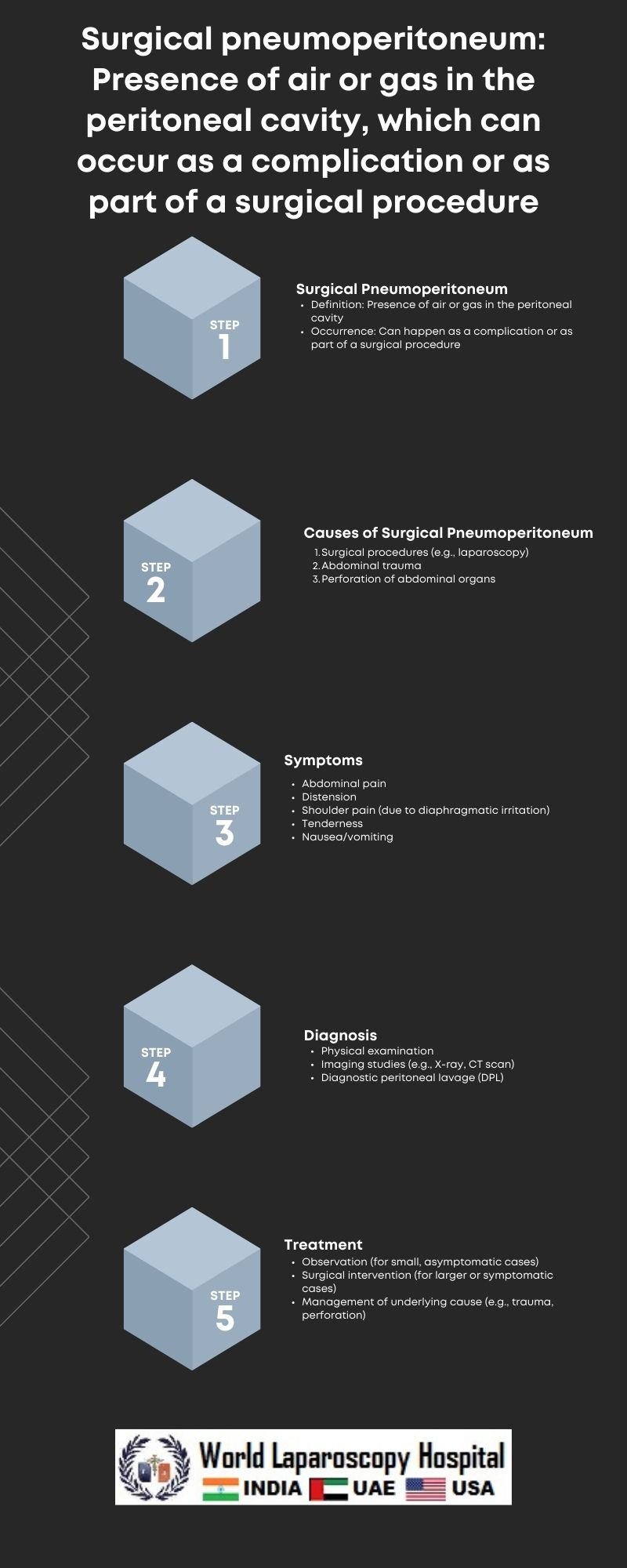Surgical pneumoperitoneum: Presence of air or gas in the peritoneal cavity, which can occur as a complication or as part of a surgical procedure
Introduction
Surgical pneumoperitoneum, the presence of air or gas in the peritoneal cavity, is a common occurrence in surgical practice. It can occur as a complication of various procedures or as a deliberate part of laparoscopic surgeries. Understanding the causes, complications, and management of pneumoperitoneum is essential for surgeons and healthcare providers to ensure optimal patient outcomes.

Causes of Surgical Pneumoperitoneum
-
Laparoscopic Surgery: In laparoscopic procedures, pneumoperitoneum is intentionally created by insufflating carbon dioxide into the peritoneal cavity to create a working space for the surgical instruments.
-
Perforation: Accidental perforation of abdominal organs, such as the bowel, during surgery or due to trauma can lead to pneumoperitoneum.
-
Diagnostic Procedures: Some diagnostic procedures, such as peritoneal lavage, can inadvertently introduce air into the peritoneal cavity.
-
Mechanical Ventilation: Positive pressure mechanical ventilation can sometimes cause air to be forced into the peritoneal cavity, especially in patients with diaphragmatic defects.
-
Spontaneous: In rare cases, pneumoperitoneum can occur spontaneously without an identifiable cause.
Complications of Surgical Pneumoperitoneum
-
Cardiovascular Effects: Pneumoperitoneum can lead to increased intra-abdominal pressure, which can affect venous return and cardiac output, especially in patients with compromised cardiovascular function.
-
Respiratory Effects: Elevated intra-abdominal pressure can cause diaphragmatic splinting and impair respiratory mechanics, leading to decreased lung compliance and potential respiratory compromise.
-
Abdominal Compartment Syndrome (ACS): Pneumoperitoneum can contribute to the development of ACS, a life-threatening condition characterized by elevated intra-abdominal pressure and organ dysfunction.
-
Subcutaneous Emphysema: Air can track along tissue planes and cause subcutaneous emphysema, which is usually benign but can be a marker of underlying pathology.
-
Vascular Injury: In cases of traumatic pneumoperitoneum, vascular injury is a potential complication that requires prompt diagnosis and intervention.
Management of Surgical Pneumoperitoneum
-
Prevention: In laparoscopic surgery, careful attention to insufflation pressures and techniques can help prevent excessive pneumoperitoneum and its associated complications.
-
Monitoring: Continuous monitoring of intra-abdominal pressure is essential in patients at risk of developing abdominal compartment syndrome.
-
Treatment of Underlying Cause: Addressing the underlying cause of pneumoperitoneum, such as repairing a perforated bowel, is crucial for successful management.
-
Symptomatic Management: Managing symptoms associated with pneumoperitoneum, such as pain and discomfort, is an important aspect of patient care.
-
Surgical Intervention: In cases of severe abdominal compartment syndrome or vascular injury, surgical intervention may be necessary to relieve pressure or repair damaged vessels.
Conclusion
Surgical pneumoperitoneum is a common occurrence in surgical practice, with laparoscopic procedures being a major cause. Understanding the causes, complications, and management of pneumoperitoneum is essential for healthcare providers to ensure optimal patient outcomes. By implementing preventive measures, monitoring patients at risk, and providing prompt treatment, the complications associated with pneumoperitoneum can be minimized, leading to better patient outcomes.
Pneumoperitoneum can result from laparoscopic procedures, accidental perforations during surgery or trauma, diagnostic procedures, or even mechanical ventilation. Complications may include cardiovascular and respiratory effects, abdominal compartment syndrome, subcutaneous emphysema, and vascular injury.
Managing surgical pneumoperitoneum involves prevention, continuous monitoring, treating the underlying cause, and symptomatic management. In severe cases, surgical intervention may be necessary to relieve pressure or repair damaged vessels.
| Older Post | Home | Newer Post |


